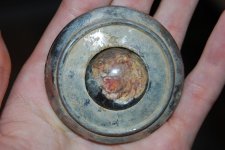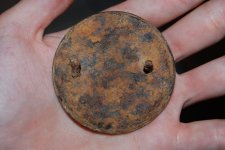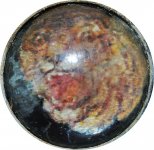JD's Variety Channel
Full Member
- Dec 27, 2012
- 120
- 281
- Detector(s) used
- Minelab E-trac w/ Sunray X-1 Probe & Teknetics T2 Special
- Primary Interest:
- Metal Detecting
I found this today and am not exactly sure what it is. It's looks similar to an antique bridle rosette from the mid 1900's, but usually they're equestrian themed. So I'm not sure. Any ideas? The design in the middle is deteriorating, and I'm not sure what it's made out of. But it looks like an early hologram, when you move it around in the light it creates an illusion like it's getting bigger, and there are definitely multiple layers to create this effect. I found an early holographic ring once with multiple phases of someone kicking a football, and if I remember correctly, it dated to around the early 1960's.
Thanks for the help!
Thanks for the help!

Amazon Forum Fav 👍
Attachments
Last edited:











